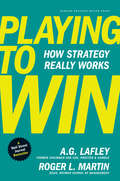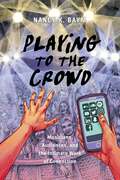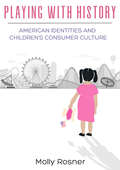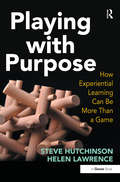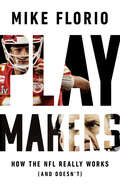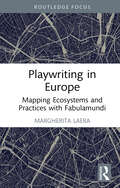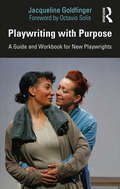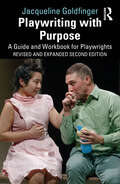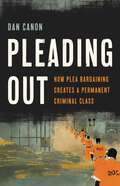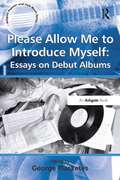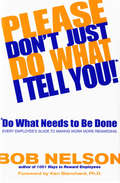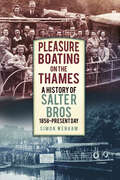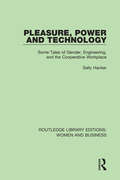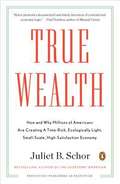- Table View
- List View
Playing to Win
by A. G. Lafley Roger L. MartinThis is A.G. Lafley's guidebook. Shouldn't it be yours as well?Winning CEO A.G. Lafley is now back at the helm of consumer goods giant Procter & Gamble. If you want to know the strategy he'll use to restore P&G to its former dominance-read this book.Playing to Win, a noted Wall Street Journal and Washington Post bestseller, outlines the strategic approach Lafley, in close partnership with strategic adviser Roger Martin, used to double P&G's sales, quadruple its profits, and increase its market value by more than $100 billion when Lafley was first CEO (he led the company from 2000 to 2009). The book shows leaders in any type of organization how to guide everyday actions with larger strategic goals built around the clear, essential elements that determine business success-where to play and how to win.Lafley and Martin have created a set of five essential strategic choices that, when addressed in an integrated way, will move you ahead of your competitors. They are: (1) What is our winning aspiration? (2) Where will we play? (3) How will we win? (4) What capabilities must we have in place to win? and (5) What management systems are required to support our choices? The result is a playbook for winning.The stories of how P&G repeatedly won by applying this method to iconic brands such as Olay, Bounty, Gillette, Swiffer, and Febreze clearly illustrate how deciding on a strategic approach-and then making the right choices to support it-makes the difference between just playing the game and actually winning.Playing to Win outlines a proven method that has worked for some of today's most celebrated brands and products. Let this book serve as your new guide to winning, as well.
Playing to Win: 1. Strategy Is Choice
by A. G. Lafley Roger L. MartinPlay to Win: How Strategy Really Works is an 8-chapter books published in 2013 by Harvard Business Review Press and written by former Procter & Gamble CEO A.G. Lafley and Rotman School of Management Dean Roger L. Martin. The authors present a framework for creating strategy based on a decade of work at P&G. The framework is a strategic choice cascade, made up of 5 decision points that apply to companies of all sizes and in all markets. The model guides leaders in making choices around a winning aspiration, where to play, how to win, core capabilities, and management systems and is enriched by using the context of P&G's experience. The authors provide perspectives on how to put the framework into practice, offering practical tips and personal insights. In Chapter 1, Strategy Is Choice (28 pages), the authors use the story of P&G's revitalization of the Oil of Olay brand to introduce their strategic framework, a "strategic choice cascade" of five questions that help a company develop a shared understanding of its strategy and the plan to achieve it. The authors look at each question in the framework as well as the interaction among them.
Playing to Win: 2. What Is Winning?
by A. G. Lafley Roger L. MartinPlay to Win: How Strategy Really Works is an 8-chapter books published in 2013 by Harvard Business Review Press and written by former Procter & Gamble CEO A.G. Lafley and Rotman School of Management Dean Roger L. Martin. The authors present a framework for creating strategy based on a decade of work at P&G. The framework is a strategic choice cascade, made up of 5 decision points that apply to companies of all sizes and in all markets. The model guides leaders in making choices around a winning aspiration, where to play, how to win, core capabilities, and management systems and is enriched by using the context of P&G's experience. The authors provide perspectives on how to put the framework into practice, offering practical tips and personal insights. Chapter 2, What Is Winning? (16 pages), looks at the first question in the choice cascade about the company's winning aspiration. This aspiration defines the company's purpose and establishes the context for the strategy to follow. The authors emphasize that a successful company focuses on winning -not just participating-to be able to prioritize and commit to the difficult choices that inevitably arise. The authors explore winning aspirations through two real world examples: the GM launch of Saturn and P&G's decision to outsource global business services at the end of the 1990s. The chapter includes an essay, "Strategy as Winning."
Playing to Win: 3. Where to Play
by A. G. Lafley Roger L. MartinPlay to Win: How Strategy Really Works is an 8-chapter books published in 2013 by Harvard Business Review Press and written by former Procter & Gamble CEO A.G. Lafley and Rotman School of Management Dean Roger L. Martin. The authors present a framework for creating strategy based on a decade of work at P&G. The framework is a strategic choice cascade, made up of 5 decision points that apply to companies of all sizes and in all markets. The model guides leaders in making choices around a winning aspiration, where to play, how to win, core capabilities, and management systems and is enriched by using the context of P&G's experience. The authors provide perspectives on how to put the framework into practice, offering practical tips and personal insights. Chapter 3, Where to Play (23 pages), moves to the second step of the framework, making market decisions connected company's winning aspiration. Market choices define the company's business focus and set the stage for the challenges to come. The authors divide these choices into five dimensions: geography, product type, consumer segment, distribution channel, and vertical stage of production. They explain that while these dimensions are the same for all companies, the significance of each dimension is variable, and they illustrate with an analysis of P&G's Bounty brand. The authors also discuss the role of the competitive arena and highlight common problems that companies face in making market decisions. They look in depth at how P&G found new markets for established brands.
Playing to Win: 6. Manage What Matters
by A. G. Lafley Roger L. MartinPlay to Win: How Strategy Really Works is an 8-chapter books published in 2013 by Harvard Business Review Press and written by former Procter & Gamble CEO A.G. Lafley and Rotman School of Management Dean Roger L. Martin. The authors present a framework for creating strategy based on a decade of work at P&G. The framework is a strategic choice cascade, made up of 5 decision points that apply to companies of all sizes and in all markets. The model guides leaders in making choices around a winning aspiration, where to play, how to win, core capabilities, and management systems and is enriched by using the context of P&G's experience. The authors provide perspectives on how to put the framework into practice, offering practical tips and personal insights. Chapter 6, Manage What Matters (29 pages), examines the last step in the model, management systems. The authors argue that successful strategy requires a company's leaders to actively implement and support its strategy with the right processes and systems. This includes implementing systems for creating and reviewing the strategy, creating structures to support the organization's core capabilities, and taking measures to ensure that the strategy is working. The authors look at the importance and role of corporate culture, communication channels, and measurement tools, drawing on a number of approaches and strategies employed by P&G management teams. The chapter includes the essay "Communicating to the Organization."
Playing to Win: 7. Think Through Strategy
by A. G. Lafley Roger L. MartinPlay to Win: How Strategy Really Works is an 8-chapter books published in 2013 by Harvard Business Review Press and written by former Procter & Gamble CEO A.G. Lafley and Rotman School of Management Dean Roger L. Martin. The authors present a framework for creating strategy based on a decade of work at P&G. The framework is a strategic choice cascade, made up of 5 decision points that apply to companies of all sizes and in all markets. The model guides leaders in making choices around a winning aspiration, where to play, how to win, core capabilities, and management systems and is enriched by using the context of P&G's experience. The authors provide perspectives on how to put the framework into practice, offering practical tips and personal insights. In Chapter 7, Think Through Strategy (23 pages), the authors provide guidance on how to organize strategic thinking and synthesize complex data. They offer a framework, called the "strategic logic flow," which identifies four major dimensions for leaders to consider-the industry, the customers, a company's relative position, and the competition-and then present seven questions that systematically evaluate these four dimensions. The strategic logic flow allows management to identify key areas of analysis to generate competitive advantage. The authors explain the seven questions using examples from many of P&G's business units. The chapter includes the essay "The Long Road to the Logic Flow."
Playing to Win: 8. Shorten Your Odds
by A. G. Lafley Roger L. MartinPlay to Win: How Strategy Really Works is an 8-chapter books published in 2013 by Harvard Business Review Press and written by former Procter & Gamble CEO A.G. Lafley and Rotman School of Management Dean Roger L. Martin. The authors present a framework for creating strategy based on a decade of work at P&G. The framework is a strategic choice cascade, made up of 5 decision points that apply to companies of all sizes and in all markets. The model guides leaders in making choices around a winning aspiration, where to play, how to win, core capabilities, and management systems and is enriched by using the context of P&G's experience. The authors provide perspectives on how to put the framework into practice, offering practical tips and personal insights. Chapter 8, Shorten Your Odds (28 pages), explores group decision making and provides practical insight on how to put the strategic choice cascade into practice. The authors critique the traditional approach to generating "buy-in" and offer a process to focus on the critical questions for determining strategy. This process enables leaders to "reverse engineer" the possible outcomes and make informed choices. The authors walk the reader through seven steps from framing a choice and broadening the options, to using a strategic logic flow and testing outcomes. The chapter includes two essays "The Most Important Question In Strategy" and "The Power of an Outside Strategy Partner."
Playing to Win: Conclusion. The Endless Pursuit of Winning
by A. G. Lafley Roger L. MartinPlay to Win: How Strategy Really Works is an 8-chapter books published in 2013 by Harvard Business Review Press and written by former Procter & Gamble CEO A.G. Lafley and Rotman School of Management Dean Roger L. Martin. The authors present a framework for creating strategy based on a decade of work at P&G. The framework is a strategic choice cascade, made up of 5 decision points that apply to companies of all sizes and in all markets. The model guides leaders in making choices around a winning aspiration, where to play, how to win, core capabilities, and management systems and is enriched by using the context of P&G's experience. The authors provide perspectives on how to put the framework into practice, offering practical tips and personal insights. In their Conclusion, The Endless Pursuit of Winning (6 pages), the authors provide a brief recap of their strategic model and offer their perspective on implementing strategy in a changing and volatile world. They outline the common mistakes that companies make in creating a strategy, such as targeting too many customer types, competing in too broad a marketplace, and not choosing a distinctive strategy. They also outline key indicators of a winning strategy, including internal strategic tools and external factors such as customer response and competitor relationships.
Playing to Win: Introduction, How Strategy Really Works
by A. G. Lafley Roger L. MartinPlay to Win: How Strategy Really Works is an 8-chapter books published in 2013 by Harvard Business Review Press and written by former Procter & Gamble CEO A.G. Lafley and Rotman School of Management Dean Roger L. Martin. The authors present a framework for creating strategy based on a decade of work at P&G. The framework is a strategic choice cascade, made up of 5 decision points that apply to companies of all sizes and in all markets. The model guides leaders in making choices around a winning aspiration, where to play, how to win, core capabilities, and management systems and is enriched by using the context of P&G's experience. The authors provide perspectives on how to put the framework into practice, offering practical tips and personal insights. The book's Introduction, How Strategy Really Works (6 pages), lays the foundation by highlighting the central concepts. The authors define strategy as making choices of what to do and what not to do, and explain why this process is essential to understanding and planning for a business. They explain briefly how they developed their framework during their time at P&G, but they also believe that this strategic process applies to companies of all sizes. The chapter ends with a look at common, yet ineffective, ways that leaders tend to approach strategy, thus setting up the arguments presented in the chapters.
Playing to the Crowd: Musicians, Audiences, and the Intimate Work of Connection (Postmillennial Pop #14)
by Nancy K. BaymExplains what happened to music—for both artists and fans—when music went online. Playing to the Crowd explores and explains how the rise of digital communication platforms has transformed artist-fan relationships into something closer to friendship or family. Through in-depth interviews with musicians such as Billy Bragg and Richie Hawtin, as well as members of the Cure, UB40, and Throwing Muses, Baym reveals how new media has facilitated these connections through the active, and often required, participation of the artists and their devoted, digital fan base.Before the rise of social sharing and user-generated content, fans were mostly seen as an undifferentiated and unidentifiable mass, often mediated through record labels and the press. However, in today’s networked era, musicians and fans have built more active relationships through social media, fan sites, and artist sites, giving fans a new sense of intimacy and offering artists unparalleled information about their audiences. However, this comes at a price. For audiences, meeting their heroes can kill the mystique. And for artists, maintaining active relationships with so many people can be both personally and financially draining, as well as extremely labor intensive.Drawing on her own rich history as an active and deeply connected music fan, Baym offers an entirely new approach to media culture, arguing that the work musicians put in to create and maintain these intimate relationships reflect the demands of the gig economy, one which requires resources and strategies that we must all come to recognize and appreciate.
Playing with FIRE (Financial Independence Retire Early): How Far Would You Go for Financial Freedom?
by Scott RieckensWhat if a happier life was only a few simple choices away? A successful entrepreneur living in Southern California, Scott Rieckens had built a &“dream life&”: a happy marriage, a two-year-old daughter, a membership to a boat club, and a BMW in the driveway. But underneath the surface, Scott was creatively stifled, depressed, and overworked trying to help pay for his family&’s beach-town lifestyle. Then one day, Scott listened to a podcast interview that changed everything. Five months later, he had quit his job, convinced his family to leave their home, and cut their expenses in half. Follow Scott and his family as they devote everything to FIRE (financial independence retire early), a subculture obsessed with maximizing wealth and happiness. Filled with inspiring case studies and powerful advice, Playing with FIRE is one family&’s journey to acquire the one thing that money can&’t buy: a simpler — and happier — life. Based on the documentary
Playing with History: American Identities and Children’s Consumer Culture
by Molly RosnerSince the advent of the American toy industry, children’s cultural products have attempted to teach and sell ideas of American identity. By examining cultural products geared towards teaching children American history, Playing With History highlights the changes and constancies in depictions of the American story and ideals of citizenship over the last one hundred years. This book examines political and ideological messages sold to children throughout the twentieth century, tracing the messages conveyed by racist toy banks, early governmental interventions meant to protect the toy industry, influences and pressures surrounding Cold War stories of the western frontier, the fractures visible in the American story at a mid-century history themed amusement park. The study culminates in a look at the successes and limitations of the American Girl Company empire.
Playing with Purpose: How Experiential Learning Can Be More Than a Game
by Steve Hutchinson Helen LawrencePlaying with Purpose shows how a facilitator, coach, manager, people developer or trainer can invent or reinvigorate an artificial learning experience and make it so much more than a game. The authors look at a range of dilemmas, challenges and problems faced by anyone wanting to run memorable training sessions, classes and project meetings and then demonstrate how to get powerful lessons from the simplest of household and office objects and situations. The exercises and ideas outlined provide a focused examination of a range of training aims and outcomes including leadership, teamwork, communications, equality and diversity, feedback and personal effectiveness; as well as general energisers, closers and problems to be solved. Steve Hutchinson and Helen Lawrence believe that seeing their sustainable, creative approach to experiential learning explicitly laid out, will give you the confidence to develop your own solutions.
Playmakers: How the NFL Really Works (And Doesn't)
by Mike FlorioThe story of a modern NFL that can&’t get out of its own way—and can&’t stop making moneyIn recent decades, the NFL has simultaneously become an athletic, financial, and cultural powerhouse—and a League that can&’t seem to go more than a few weeks without a scandal. Whether it&’s about domestic violence, performance-enhancing drugs, racism, or head trauma, the NFL always seems to be in some kind of trouble. Yet no matter the drama, the TV networks keep showing games, the revenue keeps rising, and the viewers keep tuning in.How can a sports league—or any organization—operate this way? Why do the negative stories keep happening, and why don&’t they ever seem to affect the bottom line? In this wide-ranging book, Mike Florio takes readers from the boardroom to the locker room, from draft day to the Super Bowl, answering these questions and more, and showing what really goes on in the sport that America can&’t seem to quit.Known for his constant stream of new information and incisive commentary, Florio delivers again in this book. With new insights and reporting on scandals past and present, this book will be the talk of the League—whether the League likes it or not.
Plays Well with Others: The Surprising Science Behind Why Everything You Know About Relationships Is (Mostly) Wrong
by Eric BarkerFrom the author of the Wall Street Journal bestseller Barking Up the Wrong Tree comes a cure-all for our increasing emotional distance and loneliness—a smart, surprising, and thoroughly entertaining guide to help build better friendships, reignite love, and get closer to others, whether you’re an extrovert or introvert, socially adept or socially anxious.Can you judge a book by its cover? Is a friend in need truly a friend indeed? Does love conquer all? Is no man an island? In Plays Well with Others, Eric Barker dives into these age-old maxims drawing on science to reveal the truth beyond the conventional wisdom about human relationships. Combining his compelling storytelling and humor, Barker explains what hostage negotiation techniques and marital arguments have in common, how an expert con-man lied his way into a twenty-year professional soccer career, and why those holding views diametrically opposed to our own actually have the potential to become our closest, most trusted friends.Inside you will learn:The two things essential to making friends – and what Dale Carnegie got wrong.What creates love, reignites love, and sustains love. (There’s no Build-A-Bear store for a happy marriage but this is close.)The ethical and effective way to get your partner to change.How social media can actually improve relationships.The antidote to loneliness and why what we usually hear doesn’t work.And so much more. The book is packed with high-five-worthy stories about the greatest female detective to ever live, the most successful liar to ever open his mouth, genius horses, thieving hermits, the perils of perfect memories, and placebos. Leveraging the best evidence available—free of platitudes or magical thinking—Barker analyzes multiple sides of an issue before rendering his verdict. What he’s uncovered is surprising, counterintuitive, and timely—and will change the way you interact in the world and with those around you just when you need it most.
Playwriting in Europe: Mapping Ecosystems and Practices with Fabulamundi (Routledge Advances in Theatre & Performance Studies)
by Margherita LaeraThis book maps contemporary playwriting and theatre translation practices and ecologies in the European continent. Whether you are a scholar researching contemporary drama and translation, or a theatre practitioner looking for ways to navigate theatrical conventions in other countries, this book is for you. Through questionnaires and one-to-one interviews with key stakeholders, Dr Laera collects qualitative and quantitative data about how each national theatre culture supports living dramatists, what conventions drive the production and translation (or lack thereof) of contemporary plays, and what perceptions are held by gatekeepers, theatre-makers and other cultural operators about the theatre system in which they work. Through country-by-country descriptions and analyses; interviews with playwrights, translators, directors and gatekeepers; a list of key facts and best practices; and a rigorous assessment of its methodologies, this volume is indispensable for those interested in contemporary European theatre practice.
Playwriting with Purpose: A Guide and Workbook for New Playwrights
by Jacqueline GoldfingerPlaywriting with Purpose: A Guide and Workbook for New Playwrights provides a holistic approach to playwriting from an award-winning playwright and instructor. This book incorporates craft lessons by contemporary playwrights and provides concrete guidance for new and emerging playwrights. The author takes readers through the entire creative process, from creating characters and writing dialogue and silent moments to analyzing elements of well-made plays and creating an atmospheric environment. Each chapter is followed by writing prompts and pro tips that address unique facets of the conversation about the art and craft of playwriting. The book also includes information on the business of playwriting and a recommended reading list of published classic and contemporary plays, providing all the tools to successfully transform an idea into a script, and a script into a performance. Playwriting with Purpose gives writers and students of playwriting hands-on lessons, artistic concepts, and business savvy to succeed in today’s theater industry.
Playwriting with Purpose: A Guide and Workbook for Playwrights
by Jacqueline GoldfingerPlaywriting with Purpose: A Guide and Workbook for New Playwrights, Second Edition provides a revised and greatly expanded holistic approach to playwriting from an award-winning playwright and professor.This book incorporates craft lessons, scenes for study, and concrete guidance in both the art and business of playwriting. The author takes readers through the entire creative process, from creating characters and writing dialogue to revising and producing your play. Each chapter includes incisive craft lessons, provocative writing prompts, examples from plays, tips from working artists, reading recommendations, and more. Thoroughly revised, new features to this edition include: Vastly expanded sections on structure, world building, business of playwriting, writing for television and film, and more New writing exercises and pro tips from working playwrights in each chapter An exploration of art and craft through a new selection of international plays Shorter chapters with more subject headings to make it easier to find the exact craft lesson or writing prompt you want when you want it Playwriting with Purpose gives writers and students the tools to succeed in today’s theater industry.
Plaza, the Logistics Park of Zaragoza
by Noel Watson Santiago KraiselburdIn the year 2000, the Government of the Autonomous Community of Arag n, Spain, made public a project for the development of a large-scale logistics park in the outskirts of the city of Zaragoza. With an area of nearly 13 square kilometers, PLAZA (an acronym for Zaragoza Logistics Platform) would be by far the largest logistics park either built or under development in all of Europe. This case illustrates the motivations behind such an undertaking, the reasoning used in deciding the feasibility of the location of the park, and also the advantages (and disadvantages) related to the project. The case provides sufficient data to prepare an analysis from the point of view of a potential customer, where the cost advantage or disadvantage of locating a facility in Zaragoza (with respect to Rotterdam, a preferred European location) can be quantified, and where the parameters can be changed to determine the main drivers behind such a decision, and how changes in these drivers can affect the customer's analysis. The results are meant to serve as input for PLAZA management to understand which types of customers to target, and how to address the issues that could hinder the park's projected growth.
Pleading Out: How Plea Bargaining Creates a Permanent Criminal Class
by Dan CanonA blistering critique of America&’s assembly-line approach to criminal justice and the shameful practice at its core: the plea bargain Most Americans believe that the jury trial is the backbone of our criminal justice system. But in fact, the vast majority of cases never make it to trial: almost all criminal convictions are the result of a plea bargain, a deal made entirely out of the public eye. Law professor and civil rights lawyer Dan Canon argues that plea bargaining may swiftly dispose of cases, but it also fuels an unjust system. This practice produces a massive underclass of people who are restricted from voting, working, and otherwise participating in society. And while innocent people plead guilty to crimes they did not commit in exchange for lesser sentences, the truly guilty can get away with murder. With heart-wrenching stories, fierce urgency, and an insider&’s perspective, Pleading Out exposes the ugly truth about what&’s wrong with America&’s criminal justice system today—and offers a prescription for meaningful change.
Please Allow Me to Introduce Myself: Essays On Debut Albums (Ashgate Popular and Folk Music Series)
by George PlasketesDebut albums are among the cultural artefacts that capture the popular imagination especially well. As a first impression, the debut album may take on a mythical status, whether the artist or group achieves enduring success or in rare cases when an initial record turns out to be an apogee for an artist. Whatever the subsequent career trajectory, the debut album is a meaningful text that can be scrutinized for its revelatory signs and the expectations that follow. Please Allow Me to Introduce Myself: Essays on Debut Albums tells the stories of 23 debut albums over a nearly fifty year span, ranging from Buddy Holly and the Crickets in 1957 to The Go! Team in 2004. In addition to biographical background and a wealth of historical information about the genesis of the album, each essay looks back at the album and places it within multiple contexts, particularly the artist’s career development. In this way, the book will be of as much interest to sociologists and historians as to culture critics and musicologists.
Please Don't Just Do What I Tell You! Do What Needs to Be Done: Every Employee's Guide to Making Work More Rewarding
by Bob NelsonThe author of the million-copy-selling 1001 Ways series shows how to get ahead by fulfilling every employers ultimate expectation. This book contains a clear message: Every boss wants an effective worker to do what most needs to be done without having to be asked. Simple? Perhaps. Easy? Not on your life. But thanks to Bob Nelson, employers and employees everywhere will be empowered by this vital message, and in the process achieve their goals and create a mutually rewarding experience. As brief, to the point, and inspiring as his previous best-selling titles, Nelsons commonsense advice can be applied to any situation, from the mailroom to the boardroom, and is illustrated with a wide array of examples and anecdotes from real life. Helping readers tap into their own intelligence, resourcefulness, and pride, Nelson demonstrates how acts of initiative both big and small can make an enormous difference in the way an employee is viewed--and rewarded--by his or her boss; he also shows how the effects of those actions benefit the entire organization. It's a perfect first day on the job book; a useful resource for any HR department; and a worthwhile investment for anyone who wants to learn more and go farther in a job, in a career, and in life.
Pleasure Boating on the Thames: A History of Salter Bros, 1858-Present Day
by Simon WenhamThe River Thames above London underwent a dramatic transformation during the Victorian period, from a great commercial highway into a vast conduit of pleasure. Pleasure Boating on the Thames traces these changes through the history of the firm that did more than any other on the waterway to popularise recreational boating. Salter Bros began as a small boat-building enterprise in Oxford and went on to gain worldwide fame, not only as the leading racing boat constructor, but also as one of the largest rental craft and passenger boat operators in the country. Simon Wenham’s illustrated history sheds light on over 150 years of social change, how leisure developed on the waterway (including the rise of camping), as well as how a family firm coped with the changes brought about by industrialisation – a business that, today, still carries thousands of passengers a year.
Pleasure, Power and Technology: Some Tales of Gender, Engineering, and the Cooperative Workplace (Routledge Library Editions: Women and Business #5)
by Sally HackerHow are the pleasures of making things work turned into processes of domination? Are there links between gender and military institutions? Does eroticism have something to do with engineering? In this book, first published in 1989, Sally Hacker explores the answers to these and other provocative questions about our attitudes toward work and leisure. Drawing from her broad experience as a sociologist, feminist and student of engineering, Hacker helps us to understand the impact of technology on our society and how feminist principles can be used to make work life more egalitarian and more humane. In the first part of the book, the author examines various examples of the masculinization of power, ranging from military institutions to the mechanisation of farm labour, computer technology and affirmative action. In the second part, Hacker presents the results of her research on Mondragon, the world’s largest cooperative workplace, located in Spain. Hacker reaches surprising conclusions about gender and technology at Mondragon, where, in spite of the community’s egalitarian philosophy, gender inequality was as pervasive as in capitalist and socialist systems.
Plenitude: The New Economics of True Wealth
by Juliet B. SchorAt a moment of ecological and financial crisis, bestselling author and economist Juliet B. Schor presents a revolutionary strategy for transitioning toward a richer, more balanced life. In Plenitude economist and bestselling author Juliet B. Schor offers a groundbreaking intellectual statement about the economics and sociology of ecological decline, suggesting a radical change in how we think about consumer goods, value, and ways to live. Humans are degrading the planet far faster than they are regenerating it. As we travel along this shutdown path, food, energy, transport, and consumer goods are becoming increasingly expensive. The economic downturn that has accompanied the ecological crisis has led to another type of scarcity: incomes, jobs, and credit are also in short supply. Our usual way back to growth-a debt-financed consumer boom- is no longer an option our households, or planet, can afford. Responding to our current moment, Plenitude puts sustainability at its core, but it is not a paradigm of sacrifice. Instead, it's an argument that through a major shift to new sources of wealth, green technologies, and different ways of living, individuals and the country as a whole can actually be better off and more economically secure. And as Schor observes, Plenitude is already emerging. In pockets around the country and the world, people are busy creating lifestyles that offer a way out of the work and spend cycle. These pioneers' lives are scarce in conventional consumer goods and rich in the newly abundant resources of time, information, creativity, and community. Urban farmers, do-it-yourself renovators, Craigslist users-all are spreading their risk and establishing novel sources of income and outlets for procuring consumer goods. Taken together, these trends represent a movement away from the conventional market and offer a way toward an efficient, rewarding life in an era of high prices and traditional resource scarcity. Based on recent developments in economic theory, social analysis, and ecological design as well as evidence from the cutting-edge people and places putting these ideas into practice, Plenitude is a road map for the next two decades. In encouraging us to value our gifts- nature, community, intelligence, and time-Schor offers the opportunity to participate in creating a world of wealth and well-being. .
